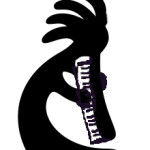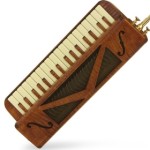Hohner Piano 36
Tagged: 64 chrometta, Hohner Piano 36
- This topic has 23 replies, 11 voices, and was last updated 9 years, 5 months ago by
 Adam Tombs.
Adam Tombs.
-
AuthorPosts
-
November 15, 2013 at 5:27 am #934
 OdeMXParticipant
OdeMXParticipantFound a used Hohner I like the look of it, it cost around $100dlls with delivery, but I also found a 64 chromonica professional model Hohner Armonica for the same price, that I could really use. There is also a Hohner27 which I know is many ppl favorite, but I’m not interested since it can’t replace my Suzuki IMHO.
Any of you have tried the Piano36? I have read mixed reviews, people either say it’s the best or the worst.
November 16, 2013 at 6:31 pm #936 DarenKeymaster
DarenKeymasterI played a Piano36 years ago, but really can’t remember what it was like. Maybe I’d remember if I was totally blown away!
November 19, 2013 at 8:27 pm #941 KevinParticipant
KevinParticipantI recently was lucky enough to come across a new old-stock(never sold) Hohner36 on eBay and I can give you my opinion.
The construction is quite good and it is better quality than the 32 and 26 key model from that same era and quite different in design. The end caps are plastic but the bottom plate which has a very shallow V shape is made of metal. The melodica doesn’t have any holes anywhere in the body so if you are recording you want to turn the keyboard side towards the mic.
Playing: I have owned Suzukis, Yamaha, new and vintage Hohners, and several other lesser known manafacturers and I have to say that the 36 is the most comfortable keyboard of them all. The amount of key dip and springyness seem just right to me. The other great advantage is that although the body is the same length as other brands of melodicas the 36 notes means there’s room to make the keys slightly wider. You wouldn’t think this would make a difference but it is quite surprising how much more comfortable it is to play on, especially if you are coming from a full size keyboard background.
Where I think the instruments sufferers is airflow. It’s not very even across the keyboard and I have to blow harder and softer in different octaves and there is a bit of delay from breath to note. Hohner’s philosophy seems to be to have air channels instead of blowing straight across the reeds. When you look inside the mouthpiece connects to a long channel that leads down to the highest notes first and then to the low notes.
I don’t want to say too much about the sound, as it’s subjective it does sound quite different from the new Hohners and the vintage 32 note both of which I have tried it against.
If you search on YouTube there are several videos of people playing one.
I hope this helps if you have more specific questions let me know and I will try to answer.November 23, 2013 at 6:14 pm #973 OdeMXParticipant
OdeMXParticipantThank you for your detailed andvice and the time you took to write it, it convinced me to get it.
Sadly the guy that is selling it dont want to ship it.On the bright side, I found a Suzuki 36b for a decent price that I might get if the guy lowers the price!
November 23, 2013 at 9:27 pm #978 KevinParticipant
KevinParticipantYou’re welcome OdeMX,
I’m glad I could help, but too bad about the shipping.
They seem to come up for sale fairly frequently on the auction sites, maybe you will have another chance.
…Who knows, maybe you can convince me to part with mine. 🙂January 5, 2014 at 6:41 am #1378simchaleh
ParticipantHey kevin, how would u compare it with a yamaha pianica 36.
Im looking to buy my first melodica. Im a performing piano and keyboard player, and wouldnlike something different, for partabilitiy and new options for performing.
I may be able to buy an unused vintage honer 36 for a good price, and im not sure which to pick. The pianica or the hohner.
Im looking for a warmer tone. Not bright screaming tones and a quick resposnive keybed.
The only thing that worries me aobut the vintage hohner, is what u mentioned about the airflow not being smooth…January 7, 2014 at 8:00 pm #1381 KevinParticipant
KevinParticipantHi Simchaleh,
I wouldn’t just take my word for it! It’s possible the Hohner I got may have been damaged or possibly a dud(it’s the only one I’ve played)?
It is true that it is constructed with an air channel and the air chamber is much larger than the Yamaha.
I’d say the Yamaha is easier for air control but the Hohner beats all with it’s keyboard.
The Yamaha’s keyboard is more resistant(tighter springs?) and may make your fingers feel crammed together because of the size.
The Yamaha may be a little faster response.
Another thing to consider is that the Yamaha is lighter to hold than the Hohner.
They both have a warm tone. I find the Yamaha to be a little reedier but perhaps more expressive.
My ultimate advise would be to spring for both if possible then you have a couple of colors to work with.January 12, 2014 at 11:51 am #1462 LowboyParticipant
LowboyParticipantHi All,
I own three Hohner Piano 36 melodicas: two vintage ones from Germany, and one I purchased about 10 years ago before Hohner ceased production of the Piano 36. I also own a vintage Hohner Piano 26 and two vintage Hohner 32 models. I purchased a Suzuki Pro37-V2 about 6 weeks ago from Amazon but returned it after trying it out for a few days. I did not like the tone. The tone was very bright like brass or a bright accordion. I play the blues, and so I like the mellower darker sound of the Piano 36. The Suzuki I received was not tuned very well.
After 40 years of playing Hammond organ in Blues and R&B bands, I am switching to melodica. (That that is a story for another day.) The Piano 36 is a good melodica for general use in my opinion. It feels and acts like a real instrument. The sound is just right for me. The key action is great (long throw, fairly quiet) and enables fast runs.
The two vintage Piano 36s I own sound a little bit smoother (barely perceptible) than the newer one. They are definitely in better tune than the newer one. (No melodicas seem to be in perfect tune. A master accordion repair technician told me melodicas were intended primarily as a single note instrument, so perfect tuning was not a priority. I like to honk chords and play intervals, so tuning is important to me. Some dissonance is charming, but too much does not sound good.) By the way, I really love the sound of the Piano 32s with the holes on the bottom. It is very smooth with minimal harmonic content. (At least that is the way it sounds with the sound projected from the bottom. If you play it upside down, with the holes facing up, it is still smooth, but you hear more harmonics.)
I hope above information is helpful.
Lowboy
January 12, 2014 at 12:03 pm #1463 LowboyParticipant
LowboyParticipantBy the way, I feel the air flow through the Piano 36 is very good. Very little resistance and the melodica is loud. No problems with note response; it is near instantaneous over 95 percent of the range. The very lowest notes respond a bit slower as they do on any melodica, but not to the extent they influence my playing.
The Piano 32s and Piano 26 are harder to blow and quieter, but they have a smoother sound which I like for slow quiet blues.
Lowboy
January 12, 2014 at 6:40 pm #1464 QuetscherParticipant
QuetscherParticipantI’m under the impression that the reception of a melodica depends very much on how many different melodicas a player plays and which melodica he was most content with first or is currently most content with.
Kevin seems to be a player who owns and really plays many different melodicas whereas Lowboy seems be a great Piano 36 fan who plays one or two melodicas besides.
My first melodica was the Piano 36 and I played it for more than 10 years before even touching another instrument; then two years ago I bought a Vibrandoneon and since then play it nearly exclusively. I would never have considered the airflow problem if Kevin hadn’t mentioned it, but when I read Kevin’s review of the Piano 36 I decided to try out whether that phenomenon exists with my Piano 36 and, yes, it does! But that’s no problem for me because I have been playing it for such a long time and I’m used to it’s, let’s say, oddities. On the other hand, if I had played a Vibrandoneon first and then tried out the Piano 36, I would hardly have given it 5 Stars, but in fact for me the Piano 36 is a great melodica – and who would compare a VW with a Mercedes Benz!
January 14, 2014 at 12:52 am #1480 KevinParticipant
KevinParticipantThank-you Quetscher, It’s a relief to know it’s not just my 36 that was failing. I was a little afraid I had got the back plate on wrong. :-/
What I’ve noticed is the distance from the instrument seems to make the problem worse. Playing through a tube with an improvised connector mainly wrapping vinyl tape around the hose till it fit the diameter. I really can’t get much tone and have to take a new gulp of air for almost every note in the low register. The angled mouthpiece works fine for the first two octaves but the lower notes go wildly flat and the low G actually makes a sort of braying sound like a blues harmonica player might covet. The trumpet mouthpiece is better but there is still some flatting on the low notes and finally blowing directly into the body of the instrument it seems to play fine. I hadn’t noticed before but It seems most of the players I’ve seen using the Piano-36 seem to be blowing directly into it. I had thought this was just a matter of personal taste or losing the mouthpiece but now I’m wondering if they had the same experience?


Don’t know if the images posted?January 14, 2014 at 12:38 pm #1499 QuetscherParticipant
QuetscherParticipantHi Alan,
I never played the Piano 36 with a hose but always with the trumpet mouthpiece because you have better possibilities to modulate the sound; so I don’t know if it reacts differently with hose or without any mouthpiece. But what comes into my mind is that I often played without the water key, although it’s quite a mess with moisture coming out of the air hole while playing – to me it sounded a little warmer and softer. And perhaps this also leads to a more constant airflow through the octaves. I’ll try and report.
January 14, 2014 at 1:07 pm #1500 QuetscherParticipant
QuetscherParticipantSorry, the last one was for Kevin, not for Alan:-)
January 14, 2014 at 1:16 pm #1501 LowboyParticipant
LowboyParticipantHi All,
Yes, as you play the upper octave of the Piano 36, the volume seems to increase, and you must cut back on pressure or risk playing notes that are too loud and harsh. But you get use to cutting back on pressure very quickly. It is no different than applying dynamic control on any instrument such as guitar or organ. One of great things about the melodica is the instantaneous, instinctual, and precise control you have over dynamics. I love it. It is very expressive.
These days, I play the Piano 36 with the trumpet mouthpiece. I often hold the melodica from the bottom, cradled in my hand. I keep a cloth in my hand so the melodica also sits in the cloth. The cloth gathers moisture that tends to weep out. The cloth is also right there for when I clean the water valve discretely. I always play with the water valve closed, otherwise I get winded pretty quickly. The brightly colored cloth is also there for show. I tend to hold the melodica against my chest so I feel in full contact with the instrument. I can feel the vibrations and feel like I am connected to the instrument.
Lowboy
January 14, 2014 at 2:37 pm #1503 LowboyParticipant
LowboyParticipantClarification: When I say I hold the melodica from the bottom, I mean the end of the instrument opposite the mouthpiece, not the flat bottom of the instrument where the strap is located.
Lowboy
-
AuthorPosts
- You must be logged in to reply to this topic.
